This site uses cookies as defined in our Cookie Policy, by continuing to use this site you agree to their use.
Continue
| Arrive | Depart | ||||||
| 27th27 | AugAug | 202525 | Copenhagen, Denmark, embark on the Silver Spirit | 19:00 | |||
By the 11th century, Copenhagen was already an important trading and fishing centre and today you will find an attractive city which, although the largest in Scandinavia, has managed to retain its low-level skyline. Discover some of the famous attractions including Gefion Fountain and Amalienborg Palace, perhaps cruise the city’s waterways, visit Rosenborg Castle or explore the medieval fishing village of Dragoer. Once the home of Hans Christian Andersen, Copenhagen features many reminders of its fairytale heritage and lives up to the reputation immortalised in the famous song ‘Wonderful Copenhagen’. Effortlessly cool and down to earth, Copenhagen is a contemporary, clean and classy highlight of Scandinavia. A city built to be liveable, Copenhagen has refused to compromise, resulting in a forward-thinking metropolis that’s green and clean. Swim in the waters of Havnebadet Islands during summer, or shelter from winter’s bite by snuggling in beside a roaring open fire during winter. You can even hop on a train to Sweden, traversing the famous span of a Nordic Noir star - the Öresund Bridge. It takes just a touch over half an hour to step off the train in Malmö. There’s only one way to truly explore Copenhagen and that’s on two wheels. Easy bike hire schemes will get you moving across this flat city, designed with bikes at the forefront of the mind. Choose a model with electronic assistance to take the strain out of any journey, giving you the freedom to whizz around and explore the modern angular architecture of the centre, and the pastoral colours of Nyhavn waterfront. Head out to the Little Mermaid statue, inspired by Hans Christian Andersen’s fairy tale - the strikingly-restrained statue is the perfect landmark for Copenhagen; unshowy, self-assured and utterly irresistible. The Danish concept of hygge is very much alive here, and you’ll feel that warm cosy feeling as you visit cafes illuminated by the warm glow of hanging filament bulbs, and stuffed to the brim with thick, dusty books. Home to mega-brewer Carlsberg, Copenhagen is also a city for hop enthusiasts, and there is a thriving craft brewing scene to sample. Danish Smørrebrød sandwiches are a must try, or for something a little more substantial, settle in for a culinary voyage and try a taster menu – the city’s restaurants are littered with Michelin stars. | |||||||
| 28th28 | AugAug | 202525 | Gothenburg, Sweden | 08:00 | 19:00 | ||
Don't tell the residents of Göteborg that they live in Sweden's "second city," but not because they will get upset (people here are known for their amiability and good humor). They just may not understand what you are talking about. People who call Göteborg (pronounced YOO-teh-bor; most visitors stick with the simpler "Gothenburg") home seem to forget that the city is diminutive in size and status compared to Stockholm.Spend a couple of days here and you'll forget, too. You'll find it's easier to ask what Göteborg hasn't got to offer rather than what it has. Culturally it is superb, boasting a fine opera house and theater, one of the country's best art museums, as well as a fantastic applied-arts museum. There's plenty of history to soak up, from the ancient port that gave the city its start to the 19th-century factory buildings and workers' houses that helped put it on the commercial map. For those looking for nature, the wild-west coast and tame green fields are both within striking distance. And don't forget the food. Since its inception in 1983, more than half of the "Swedish Chef of the Year" competition winners were cooking in Göteborg. Don't tell the residents of Göteborg that they live in Sweden's "second city," but not because they will get upset (people here are known for their amiability and good humor). They just may not understand what you are talking about. People who call Göteborg (pronounced YOO-teh-bor; most visitors stick with the simpler "Gothenburg") home seem to forget that the city is diminutive in size and status compared to Stockholm. Spend a couple of days here and you'll forget, too. You'll find it's easier to ask what Göteborg hasn't got to offer rather than what it has. Culturally it is superb, boasting a fine opera house and theater, one of the country's best art museums, as well as a fantastic applied-arts museum. There's plenty of history to soak up, from the ancient port that gave the city its start to the 19th-century factory buildings and workers' houses that helped put it on the commercial map. For those looking for nature, the wild-west coast and tame green fields are both within striking distance. And don't forget the food. Since its inception in 1983, more than half of the "Swedish Chef of the Year" competition winners were cooking in Göteborg. | |||||||
| 29th29 | AugAug | 202525 | At Sea | ||||
| 30th30 | AugAug | 202525 | Lerwick, Shetland Islands, Scotland | 08:00 | 19:00 | ||
Founded by Dutch fishermen in the 17th century, Lerwick today is a busy town and administrative center. Handsome stone buildings—known as lodberries—line the harbor; they provided loading bays for goods, some of them illegal. The town's twisting flagstone lanes and harbor once heaved with activity, and Lerwick is still an active port today. This is also where most visitors to Shetland dock, spilling out of cruise ships, allowing passengers to walk around the town. Adrift between the Scottish and Norwegian coasts the craggy Shetland Islands form the most northerly point of the British Isles. Sprawling across 100 islands connected by sandy bridges and crisscrossing ferries explore the highlights of this scenic archipelago outpost. Look out over dramatic coastline from atmospheric Iron Age towers. Sweeping windswept beaches and wisps of sand connect islands and rugged cliffs - stand back as the sounds of the waves smashing against the shore and calling gulls fills the air. The islands are also home to some of the most adorable four-legged creatures you’ll ever meet the diminutive and wavy-fringed Shetland Ponies who roam the hills and reach a maximum size of 42 inches. Don't be fooled though they are amongst the strongest and toughest of all breeds. Their existence here points to Viking history as local horses bred with ponies brought ashore by Norse settlers creating the lovable crossbreed that is an icon of these islands today. The towering Broch of Mousa is perhaps Europe’s best-preserved Iron Age building - and one of the Shetland's finest brochs - a series of round stone towers believed to have been constructed around 100 BC. Seals and birdlife ensure that the isolated islands are always well-populated with life - and you can embark on hikes to discover their coastal homes. Lerwick is the islands’ capital and there's a charming welcome on offer as you arrive before the waterfront of stone buildings which cascade down to the shore. | |||||||
| 31st31 | AugAug | 202525 | Kirkwall, Orkney Islands, Scotland | 08:00 | 19:00 | ||
In bustling Kirkwall, the main town on Orkney, there's plenty to see in the narrow, winding streets extending from the harbor. The cathedral and some museums are highlights. Scattered just off the northern tip of Scotland Kirkwall is the capital of the Orkney Islands - a scenic archipelago of fascinating dual heritage. The Viking influence is deep while a prehistoric past and World War history adds to the endless stories that these dramatic islands have to tell. Sparse and beautiful let the sweeping seascapes of frothing waves and dance of the northern lights enchant you as you explore. Windswept beaches are inhabited by whooping swans while grassy cliffs hide puffins amid their wavy embrace. Sea caves and crumbling castles - and the dramatic meeting of the North Sea and the Atlantic Ocean add to the romantic beauty of these lands which may be physically close to the UK but feel an entire world away. The sandstone St. Magnus Cathedral is the centrepiece of Orkney's main town - a place of winding lanes and atmospheric walks - and Britain's northernmost cathedral is a masterpiece that took 300 years to complete. Started in 1137 the beautiful cathedral is adorned with mesmerising stain-glass windows and has been evocatively named as the Light of the North. Look down over the ruined Bishop’s and Earl’s Palaces nearby from the tip of the cathedral's tower. Or test out the islands' history-rich distilleries which produce smokey single malts - said to be the best in the world. You can also venture out to Europe's best-preserved Stone Age Village at the extraordinary World Heritage Site of Skara Brae which offers an unparalleled vision into prehistoric life. | |||||||
| 1st01 | SepSep | 202525 | Stornoway, Isle of Lewis, Scotland | 08:00 | 19:00 | ||
Tour description Stornoway, Scotland The Isle of Lewis and Harris is the northernmost and largest of the Outer Hebrides-the Western Isles in common parlance. The island's only major town, Stornoway, is on a nearly landlocked harbor on the east coast of Lewis. It's the port capital for the Outer Hebrides and the island's cultural center, such that it is. Stornoway has an increasing number of good restaurants. Lewis has some fine historic attractions, including the Calanais Standing Stones-a truly magical place. The Uists are known for their rare, plentiful wildlife. Stornoway. Besides being the island's main entry point for ferries, Stornoway is also Lewis's main arts center. You'll find some good restaurants in town if you want to have lunch off the ship. The town can be explored by bicycle if you are so inclined. Local rental shops can give you advice on where to ride, including a route to Tolsta that takes in five stunning beaches before reaching the edge of moorland. An Lanntair Arts Centre. The fabulous An Lanntair Arts Centre has exhibitions of contemporary and traditional art, as well as a cinema, a gift shop, and a restaurant serving international and Scottish fare. There are frequent traditional musical and theatrical events in the impressive auditorium. Kenneth St.. Black House. In the small community of Arnol, the Black House is a well-preserved example of an increasingly rare type of traditional Hebridean home. Once common throughout the islands-even into the 1950s-these dwellings were built without mortar and thatched on a timber framework without eaves. Other characteristic features include an open central peat hearth and the absence of a chimney-hence the soot and the designation black. On display inside are many of the house's original furnishings. To reach Arnol from Port of Ness, head south on the A857 and pick up the A858 at Barvas. Off A858, 21 mi southwest of Port of Ness. Admission charged. Calanais Standing Stones. These impressive stones are actually part of a cluster of several different archaeological sites in this area. Probably positioned in several stages between 3000 BC and 1500 BC, the grouping consists of an avenue of 19 monoliths extending northward from a circle of 13 stones, with other rows leading south, east, and west. Ruins of a cairn sit within the circle on the east side. Researchers believe they may have been used for astronomical observations, but you can create your own explanations. The visitor center has an exhibit on the stones, a gift shop, and a tearoom. On an unmarked road off A858. Admission charged. Dun Carloway. One of the best-preserved Iron Age brochs (circular stone towers) in Scotland, Dun Carloway dominates the scattered community of Carloway. The mysterious tower was probably built around 2,000 years ago as protection against seaborne raiders. The Dun Broch Centre explains more about the broch and its setting. Off A857. Gearrannan. Up a side road north from Carloway, Gearrannan is an old black-house village that has been brought back to life with a museum screening excellent short films on peat cutting and weaving. For a unique experience, groups can rent the restored houses. Leverburgh. At Leverburgh you can take the ferry to North Uist. Nearby Northton has several attractions; St. Clement's Church at Rodel is particularly worth a visit. MacGillivray Centre. Located in a round building overlooking the bay, the MacGillivray Centre gives insight into the life and work of William MacGillivray (1796-1852), a noted naturalist with strong links to Harris. MacGillivray authored the five-volume History of British Birds. This is a great location for a picnic (there are tables for just such a purpose). A walk to a ruined church starts at the parking lot. A859, Northton. Seallam! Visitor Centre and Co Leis Thu? Genealogical Research Centre. The center is where you can trace your Western Isles ancestry. Photographs and interpretive signs describe the history of Harris and its people. The owners organize guided walks and cultural evenings weekly between May and September. Off A859, Northton. Admission charged. St. Clement's Church. At the southernmost point of Harris is the community of Rodel, where you can find St. Clement's Church, a cruciform church standing on a hillock. This is the most impressive pre-Reformation church in the Outer Hebrides; it was built around 1500 and contains the magnificently sculptured tomb (1528) of the church's builder, Alasdair Crotach, MacLeod chief of Dunvegan Castle. Rodel is 3 mi south of Leverburgh and 21 mi south of Tarbert. A859, Rodel. Port of Ness. The stark, windswept community of Port of Ness, 30 mi north of Stornoway, cradles a small harbor squeezed in among the rocks. Butt of Lewis Lighthouse. At the northernmost point of Lewis stands the Butt of Lewis Lighthouse, designed by David and Thomas Stevenson (of the prominent engineering family whose best-known member was not an engineer at all, but the novelist Robert Louis Stevenson). The structure was first lighted in 1862. The adjacent cliffs provide a good vantage point for viewing seabirds, whales, and porpoises. The lighthouse is northwest of Port of Ness along the B8014. Shopping Harris tweed is available at many outlets on the islands, including some of the weavers' homes; keep an eye out for signs directing you to weavers' workshops. Harris Tweed Artisans Cooperative. The Harris Tweed Artisans Cooperative sells stylish and quirky hand-crafted tweed clothing, hats, accessories, all made by artists belonging to the cooperative. 40 Point St., Stornoway. Borgh Pottery. At Borgh Pottery, open from Monday to Saturday 9:30 to 6, you can buy attractive hand-thrown studio pottery made on the premises, including lamps, vases, mugs, and dishes. Fivepenny House, A857, Borve. Scotland's Outer Hebrides can be rainy, remote and cold – yet their inhabitants rank as the happiest people in the UK. What is their secret? One trip to the lovely port of Stornoway and you’ll soon understand why. Like something on the front of a chocolate box, Stornoway is almost a cliché of everything that is lovely about remotest Scotland: buttercups glowing at the side of single track roads, wisps of bog cotton swaying in the breeze, heather was blooming on the swathes of moorland that cover the interior of the islands, dramatic, romantic landscapes as far as the eye can see … But far from being just beautiful – the mountains, hills, lunar-like rocky plateaus, moorlands, meadows, rugged coastlines and white sandy beaches not to be undermined - Stornoway is full of history, culture and unsurprisingly, more wildlife that you can shake a stick at. Set on the eastern coast of the Isle of Lewis and the Isle of Harris, Stornaway is the capital of the Outer Hebrides, and the jumping off point for all those who want to venture even further north. Although it may sound like two separate islands, Lewis and Harris are actually two parts of the one island, and as such, is full of interesting things to do while you are here. Historians will certainly want to start with the truly magical 5,000 year old Callanish Stones. Scotland’s answer to Stonehenge, these impressive stones are actually part of a cluster of several different archaeological sites in this area. Probably positioned in several stages between 3000 BC and 1500 BC, the grouping consists of an avenue of 19 monoliths extending northward from a circle of 13 stones, with other rows leading south, east, and west. Ruins of a cairn sit within the circle on the east side. Researchers believe they may have been used for astronomical observations, but you can create your own explanations. | |||||||
| 2nd02 | SepSep | 202525 | At Sea | ||||
| 3rd03 | SepSep | 202525 | Greenock, Scotland | 07:00 | 19:00 | ||
Trendy stores, a booming cultural life, fascinating architecture, and stylish restaurants reinforce Glasgow's claim to being Scotland's most exciting city. After decades of decline, it has experienced an urban renaissance uniquely its own. The city’s grand architecture reflects a prosperous past built on trade and shipbuilding. Today buildings by Charles Rennie Mackintosh hold pride of place along with the Zaha Hadid–designed Riverside Museum.Glasgow (the "dear green place," as it was known) was founded some 1,500 years ago. Legend has it that the king of Strathclyde, irate about his wife's infidelity, had a ring he had given her thrown into the river Clyde. (Apparently she had passed it on to an admirer.) When the king demanded to know where the ring had gone, the distraught queen asked the advice of her confessor, St. Mungo. He suggested fishing for it—and the first salmon to emerge had the ring in its mouth. The moment is commemorated on the city's coat of arms.The medieval city expanded when it was given a royal license to trade; the current High Street was the main thoroughfare at the time. The vast profits from American cotton and tobacco built the grand mansions of the Merchant City in the 18th century. In the 19th century the river Clyde became the center of a vibrant shipbuilding industry, fed by the city’s iron and steel works. The city grew again, but its internal divisions grew at the same time. The West End harbored the elegant homes of the newly rich shipyard owners. Down by the river, areas like the infamous Gorbals, with its crowded slums, sheltered the laborers who built the ships. They came from the Highlands, expelled to make way for sheep, or from Ireland, where the potato famines drove thousands from their homes.During the 19th century the population grew from 80,000 to more than a million. And the new prosperity gave Glasgow its grand neoclassical buildings, such as those built by Alexander "Greek" Thomson, as well as the adventurous visionary buildings designed by Charles Rennie Mackintosh and others who produced Glasgow’s Arts and Crafts movement. The City Chambers, built in 1888, are a proud statement in marble and gold sandstone, a clear symbol of the wealthy and powerful Victorian industrialists' hopes for the future.The decline of shipbuilding and the closure of the factories led to much speculation as to what direction the city would take now. The curious thing is that, at least in part, the past gave the city a new lease of life. It was as if people looked at their city and saw Glasgow’s beauty for the first time: its extraordinarily rich architectural heritage, its leafy parks, its artistic heritage, and its complex social history. Today Glasgow is a vibrant cultural center and a commercial hub, as well as a launching pad from which to explore the rest of Scotland, which, as it turns out, is not so far away. In fact, it takes only 40 minutes to reach Loch Lomond, where the other Scotland begins. A titan of culture and character, with a disarmingly warm welcome, Glasgow is a lively, Scottish city with bucket-loads of personality. Built on a bedrock of hard-work, and deep industrial roots, the city is a fascinating balance of old and new. Architectural treasures like the elegant Glasgow City Chambers of 1888 blend with new, angular shocks like the Riverside Museum and armadillo-shaped Clyde Auditorium - both part of a clutch of exciting new developments along the River Clyde’s banks. Also towering over the river - and perhaps Glasgow’s mightiest symbol - is the Titan - a colossal crane and an almighty reminder of Glasgow’s heritage as a constructor of giant battleships and cruise liners. It is far from a grey industrial city these days, however, and leafy parks, manicured gardens and stacked galleries douse the city with its colour and cultural intrigue. George Square is at the heart of it all, overlooked by Glasgow City Chambers and adorned with memorials, columns and statues honouring influential Scots and Prime Ministers of history. The sounds of shoppers and searing bagpipes rattle along the bustling Buchanan Street, where you can stroll and shop to your heart’s content. Stumble across the West End - Glasgow’s quirkier side - which is brimming with brightly painted cafes and pubs of character and characters, and the perfect spot for a sit-down. Glasgow’s Medieval Cathedral is the city’s oldest building and one of Scotland’s oldest cathedrals, while the university is an immaculate, turreted and vaulted temple of learning. With enormous concert halls, overflowing museums and storied castles, Glasgow is one of the United Kingdom’s most characterful, rewarding cities. | |||||||
| 4th04 | SepSep | 202525 | Holyhead, Wales | 08:00 | 19:00 | ||
Once a northern defense post against Irish raiders, Holyhead later became best known as a ferry port for Ireland. The dockside bustle is not matched by the town, however, which maintains just a small population. Nonetheless, thousands of years of settlement have given Holyhead rich historical ruins to explore, with more in the surrounding hiking friendly landscape. Once a major defence point against Irish invaders Holyhead now extends the hand of friendship across the Irish Sea and is a major ferry port connecting the two countries. Discover a scenic and spectacular place whatever the weather – whether the sun’s bouncing off the blotched blue sea or the waves are swelling moodily as rain thrashes down. Set on the windswept coast of North Wales South Stack Lighthouse is a stunningly perched bright white lighthouse which has been casting its gaze out across the water for more than 200 years. A rugged picturesque site to explore you can wander out across the small aluminium bridge to reach the island where it rises. Be warned there’s a steep climb down 400 steps and then a spiral of another 100 up once you’re inside but if you’re up to the physical demands the views are magnificent from the beacon that has guarded these waters for so long. Ellin's Tower also stands over the crumbling cliffs nearby and this small castellated hideout is adorned with binoculars - perfect for getting a closer look at the crowds of nesting seabirds and puffins who cling to the coastline’s stark cliffs. In Holyhead itself enthusiastic volunteers will relay the region’s seafaring history to you at the compact Maritime Museum or you can explore Breakwater Country Park - another coastal hiking spot that sits below the gentle Holyhead Mountain. Enjoy views of the Irish Sea stretching as far as the Skerries seven miles out to sea and as far as Ireland on clear days. | |||||||
| 5th05 | SepSep | 202525 | Belfast, Northern Ireland | 08:00 | 19:00 | ||
Before English and Scottish settlers arrived in the 1600s, Belfast was a tiny village called Béal Feirste ("sandbank ford") belonging to Ulster's ancient O'Neill clan. With the advent of the Plantation period (when settlers arrived in the 1600s), Sir Arthur Chichester, from Devon in southwestern England, received the city from the English Crown, and his son was made Earl of Donegall. Huguenots fleeing persecution from France settled near here, bringing their valuable linen-work skills. In the 18th century, Belfast underwent a phenomenal expansion—its population doubled every 10 years, despite an ever-present sectarian divide. Although the Anglican gentry despised the Presbyterian artisans—who, in turn, distrusted the native Catholics—Belfast's growth continued at a dizzying speed. The city was a great Victorian success story, an industrial boomtown whose prosperity was built on trade, especially linen and shipbuilding. Famously (or infamously), the Titanic was built here, giving Belfast, for a time, the nickname "Titanic Town." Having laid the foundation stone of the city's university in 1845, Queen Victoria returned to Belfast in 1849 (she is recalled in the names of buildings, streets, bars, monuments, and other places around the city), and in the same year, the university opened under the name Queen's College. Nearly 40 years later, in 1888, Victoria granted Belfast its city charter. Today its population is nearly 300,000, tourist numbers have increased, and this dramatically transformed city is enjoying an unparalleled renaissance.This is all a welcome change from the period when news about Belfast meant reports about "the Troubles." Since the 1994 ceasefire, Northern Ireland's capital city has benefited from major hotel investment, gentrified quaysides (or strands), a sophisticated new performing arts center, and major initiatives to boost tourism. Although the 1996 bombing of offices at Canary Wharf in London disrupted the 1994 peace agreement, the ceasefire was officially reestablished on July 20, 1997, and this embattled city began its quest for a newfound identity.Since 2008, the city has restored all its major public buildings such as museums, churches, theaters, City Hall, Ulster Hall—and even the glorious Crown Bar—spending millions of pounds on its built heritage. A gaol that at the height of the Troubles held some of the most notorious murderers involved in paramilitary violence is now a major visitor attraction.Belfast's city center is made up of three roughly contiguous areas that are easy to navigate on foot. From the south end to the north, it's about an hour's leisurely walk. Reborn as a cool modern city Belfast has successfully left its troubles behind emerging as a hotbed of culture and architecture where the comfort of a cosy pub is never far away. A walk across the Lagan Weir Footbridge brings you to Belfast’s fascinating Titanic District – an area of the city devoted to its rich ship-building heritage. The state-of-the-art Titanic Museum brings the story of the doomed vessel to life and is the largest museum dedicated to the infamously ‘unsinkable’ ship. There’s just enough time to give the 10-metre long Salmon of Knowledge sculpture a quick peck for luck before continuing to explore. A stark barbed wire and graffitied sheet metal barrier marks an abrupt scar through the city’s residential areas. The Peace Line was constructed during the height of the Troubles when Belfast was plagued by sectarian divisions between Protestants and Catholics. Nowadays you can jump in a black taxi tour to see the colourful murals and living history of the walls which stand as a stark reminder of the fragility of peace. After exploring the city’s historic divisions a reminder of Belfast’s uniting creativity can be found at the Metropolitan Arts Centre – a seven-storey tall building which invites light to gloriously cascade inside. The Cathedral Quarter is a cobbled blend of flower-adorned pubs restaurants and theatres and venues where music spills out onto the streets at night and many a pint is cheerily shared. | |||||||
| 6th06 | SepSep | 202525 | Fishguard, Wales | 09:00 | 19:00 | ||
| Perched on a clifftop and stunningly picturesque Fishguard is considered the very heart of North Pembrokeshire. A small market town that almost seems untouched by time you’ll find clusters of quayside cottages family businesses selling local produce and plenty of Gaelic charm! Market day falls on a Saturday and although principally food there are some stalls selling local arts and crafts too. If you are not lucky enough to be visiting on market day the pretty high street has some lovely shops where you can easily while away a couple of hours. Known internationally as the place of the last invasion of Britain when the French landed in 1797 the village heaves with history. Historians will of course already know that the two-day invasion soon failed and the peace treaty was signed in the Royal Oak pub in the market square. The calm waters are perfect for kayaking while walkers will love the national parks that are filled with signposted trails for all levels of ability. Cyclist of all levels will also be pleased Fishguard and its surroundings do have a few hills but also lots of straight roads that offer a gentle visit of the stunning landscape. If all the activity gets too much for you then why not enjoy a delicious local welsh cake in one of the pretty cafes or head to the town hall and have a look at the 100 foot long Last Invasion Tapestry a humorous and entertaining story in a Bayeux tapestry style of the 1797 invasion of mainland Britain. | |||||||
| 7th07 | SepSep | 202525 | Cobh, Ireland | 08:00 | 17:30 | ||
Cork City's nearby harbor district has seen plenty of history. Cork Harbour's draws include Fota Island—with an arboretum, a wildlife park, and the Fota House ancestral estate—and the fishing port of Cobh. The picturesque little seaside town of Cobh, pronounced Cove, has a magnificent natural harbour, the second largest in the world. This contributed to Cobh’s connection with some of the worlds most famous ships. Of all the passenger ships that sailed from here though, the most notorious must be the Titanic, Cobh being her final port of call. Not surprisingly there are plenty of memorials to the ship in town including the not to be missed is the Titanic Experience. Through interactive experiences, visitors get the chance to experience life on board the ship and to discover more about the passengers who made that ill-fated voyage. Back when the town was called Queenstown from 1849 - 1920, over 2.5 million people emigrated from Ireland through Cobh port. Some were heading to start new lives in North America, some involuntarily as convicts and others escaping famine. The Cobh Heritage Centre tells the moving stories of how these Irish people became scattered around the globe. Spike Island, just a short ferry ride away is Irelands version of Alcatraz. Over 1300 years old, the star shaped fortress later had the dubious honour of being the world’s largest prison. Daytime and spooky nighttime tours are possible for those who dare. Cobh is an extremely walkable town, down on the waterfront are some of the best views of the town. Brightly coloured houses and friendly pubs, meander up the hilly street, drawing the eye to the towns focal point, the impressive St Colman’s Cathedral towering above. | |||||||
| 8th08 | SepSep | 202525 | Falmouth, England | 08:00 | 19:00 | ||
The bustle of this resort town's fishing harbor, yachting center, and commercial port only adds to its charm. In the 18th century Falmouth was the main mail-boat port for North America, and in Flushing, a village across the inlet, you can see the slate-covered houses built by prosperous mail-boat captains. A ferry service now links the two towns. On Custom House Quay, off Arwenack Street, is the King's Pipe, an oven in which seized contraband was burned.
The bustle of this resort town's fishing harbor, yachting center, and commercial port only adds to its charm. In the 18th century Falmouth was the main mail-boat port for North America, and in Flushing, a village across the inlet, you can see the slate-covered houses built by prosperous mail-boat captains. A ferry service now links the two towns. On Custom House Quay, off Arwenack Street, is the King's Pipe, an oven in which seized contraband was burned. | |||||||
| 9th09 | SepSep | 202525 | Isle of Portland, England | 08:00 | 19:00 | ||
The Isle of Portland is a tied island, 6 kilometres long by 2.7 kilometres wide, in the English Channel. The southern tip, Portland Bill lies 8 kilometres south of the resort of Weymouth, forming the southernmost point of the county of Dorset, England. A barrier beach called Chesil Beach joins it to the mainland. The tied island of Portland sprawls out attractively into the English Channel linked to the mainland by just the Chesil barrier beach’s thin sliver of sand. Portland forms part of England’s dramatic Jurassic Coast a UNESCO World Heritage Site of limestone cliffs coastal rock formations and beautiful bays. It may be a tiny teardrop of an island but with pirate heritage historic castles and soaring lighthouses there’s a lot to keep you busy as you soak in Dorset’s relentlessly wonderful coastal appeals. Photograph the handsome white and red-banded lighthouse which watches out over the rock-interrupted waves on a breathtakingly photogenic outcrop. Flashing out warnings of a hull-shredding offshore bank the lighthouse marks the southern tip of this island and lurches out five miles towards the Channel Islands. Rock mined from Portland has been used to create some of the most famous buildings in the world including St Paul’s Cathedral and the United Nations' Building of New York. The stunning natural arch of Durdle Door is close by - looming over a scenic cove it is undoubtedly one of England’s prettiest beaches and most beautiful natural landmarks. A 16th-century Tudor castle stands guard over Portland’s harbour and was one of London 2012’s more unusual Olympic venues hosting sailing events. You can also learn of D-Day history and the role this area played in one of the most important land invasions ever seen at Castletown D-Day Centre. | |||||||
| 10th10 | SepSep | 202525 | Southampton, England, disembark the Silver Spirit | ||||
Lying near the head of Southampton Water, a peninsula between the estuaries of the Rivers Test and Itchen, Southampton is Britain’s largest cruise port. It has been one of England’s major ports since the Middle Ages, when it exported wool and hides from the hinterland and imported wine from Bordeaux. The city suffered heavy damage during World War Two and as a result the centre has been extensively rebuilt, but there are still some interesting medieval buildings including the Bargate, one of the finest city gatehouses in England. Home of the ill-fated Titanic departure, Southampton has a long maritime history. Henry V’s fleet bound for the battle of Agincourt left from here, as did the Mayflower (not from Plymouth as many believe) and the great British ocean liners, Queen Elizabeth 2 and Queen Mary both departed on their maiden voyages from the port. So suffice to say, that Southampton is a seafearing place. Today Southampton is the cruise capital of Northern Europe, so expect a city that understands how to have fun. This comes in a variety of ways: a castellated old city that has lots of charm, some excellent museums (the most notable of which is the Sea City Museum) and extensive green spaces. Authentic Tudor remains provide a fascinating insight to 15th century living while other landmarks date back even further. A stroll around the city is generous in its attractions, so there is no better way to see Southampton than on foot. Culture wise, the city’s bustling Guildhall Square is the centre for art, education and food and drink. Southampton’s location of the south coast of England means just a short distance away lie some interesting spots. Pre-historic enigma Stonehenge is less than an hour away while the quintessentially English market town Salisbury is perfect for a bit of shopping. Both are well worth a visit. For those who prefer their entertainment crafted by Mother Nature, a short ride to the New Forest will give you peace; think idyllic glades, ancient woodland, open moors, heathland and cliff top walks. | |||||||
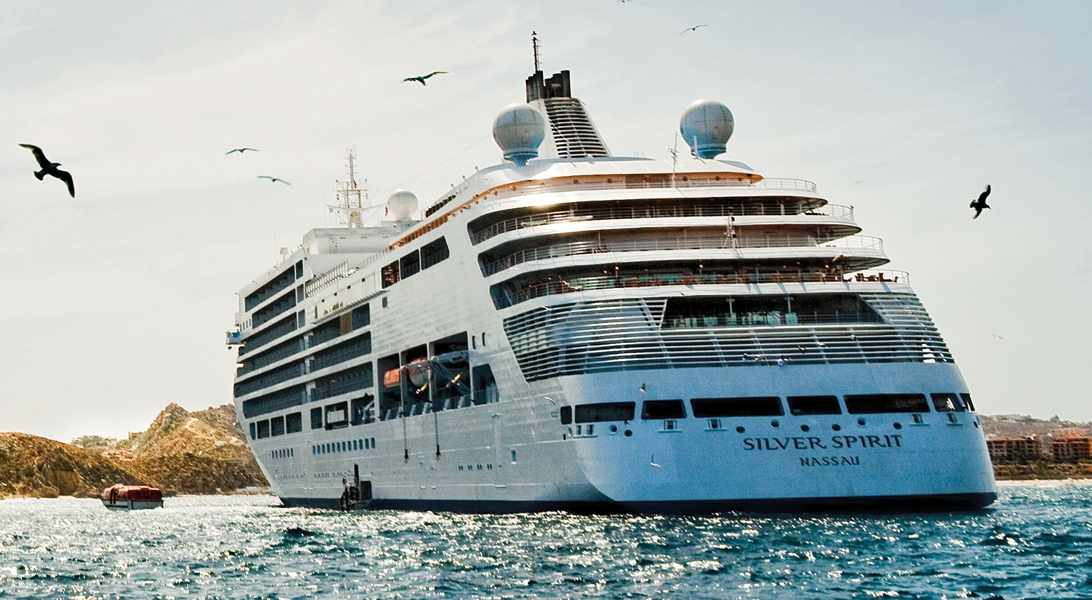
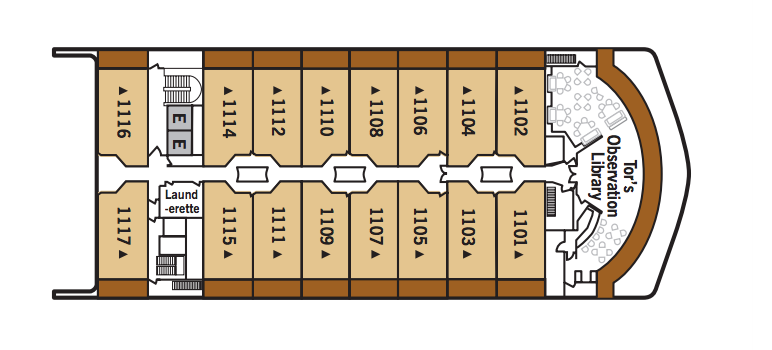







The images shown are for illustration purposes only and may not be an exact representation of what you find on the ship.
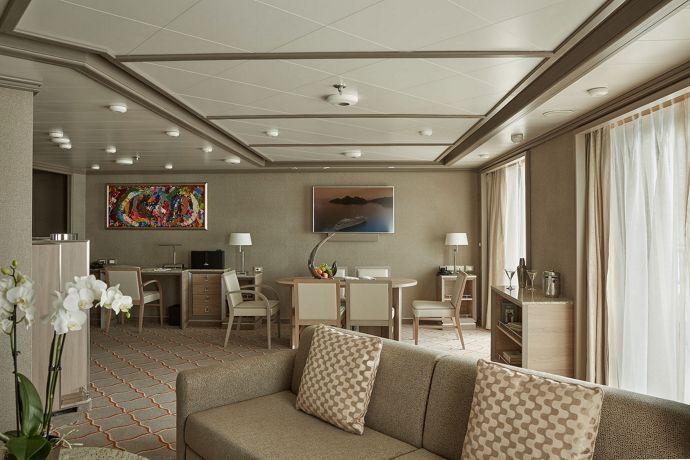
| Grade Code | From | To | |
| G1 | Grand Suite (1 Bedroom) | £24,400 | £24,400 |
| G2 | Grand Suite (2 Bedrooms) | £35,500 | £35,500 |
Expertly designed and exquisitely appointed. Ideal for entertaining friends while you cruise or enjoying a quiet dinner “at home”. Available as a one-bedroom configuration or as two-bedrooms by adjoining with a Veranda Suite.
One bedroom: 132-142 sq.m. including veranda
Two bedroom: 175 sq.m. including veranda
Please note that the 3rd guest will sleep on a comfortable sofa bed in the reception area of the suite.
Essentials
Characteristics
Furniture
Media & Communication
Onboard Services
Amenities
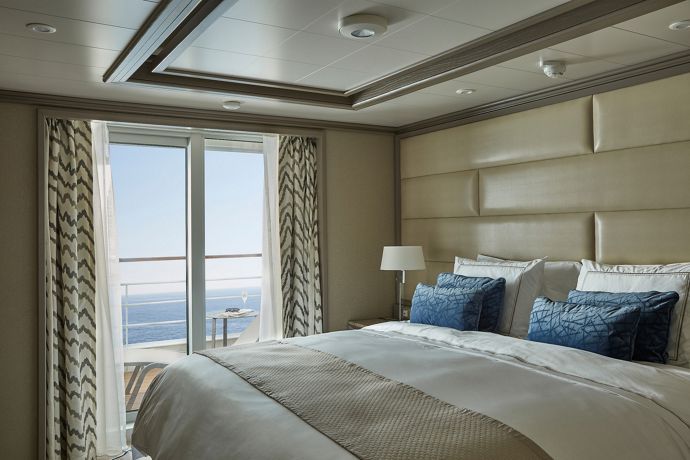
| Grade Code | From | To | |
| O1 | Owner's Suite (1 Bedroom) | £28,700 | £28,700 |
| O2 | Owner's Suite (2 Bedrooms) | £38,700 | £38,700 |
The name Owner's Suite says it all. A stylish apartment. Prestigious and classic. For those who seek the superlative level of space, comfort and service on board. Available as a one-bedroom configuration or as two-bedrooms by adjoining with Panorama Suite.
One bedroom: 1,292 sq. ft. / 120 m² including veranda
Two bedroom: 1,668 sq. ft. / 150 m² including veranda
Please note that the 3rd guest will sleep on a comfortable sofa bed in the reception area of the suite.
Essentials
Characteristics
Furniture
Media & Communication
Onboard Services
Amenities
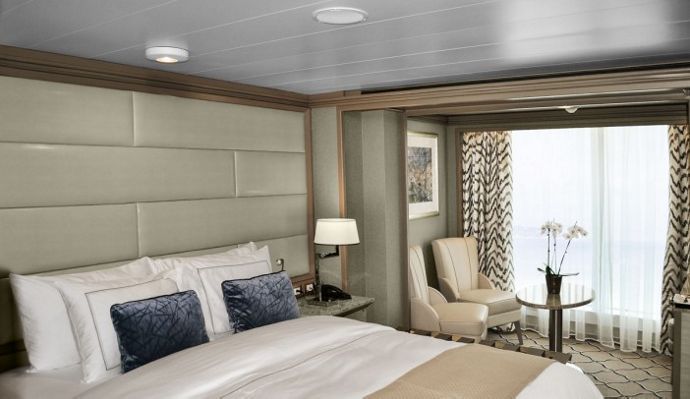
| Grade Code | From | To | |
| PA | Panorama Suite | £5,250 | £10,100 |
The Panorama Suite provides generous living space for voyagers. Located on deck 9, the Panorama offers all the comfort and attention to detail that you can expect aboard. A generous expanse of interior comforts — elegant décor, stunning marble bathroom and ample seating area, make this a cosy home away from home. The seating area of the Panorama Suite has plenty of room to relax, while large picture windows frame panoramic ocean views.
One bedroom: 334 ft² / 31 m²
Essentials
Characteristics
Furniture
Media & Communication
Onboard Services
Amenities

| Grade Code | From | To | |
| R1 | Royal Suite (1 Bedroom) | £20,000 | £20,000 |
| R2 | Royal Suite (2 Bedrooms) | £31,100 | £31,100 |
Stately describes the Royal Suite. Commanding and majestic. Perfect for entertaining. Enough living space to roam. The pinnacle of good living. Available as a one-bedroom configuration or as two bedrooms by adjoining with a Veranda Suite.
One bedroom: 92 sq.m. including veranda
Two bedroom: 127 sq.m. including veranda
Please note that the 3rd guest will sleep on a comfortable sofa bed in the reception area of the suite.
Essentials
Characteristics
Furniture
Media & Communication
Onboard Services
Amenities
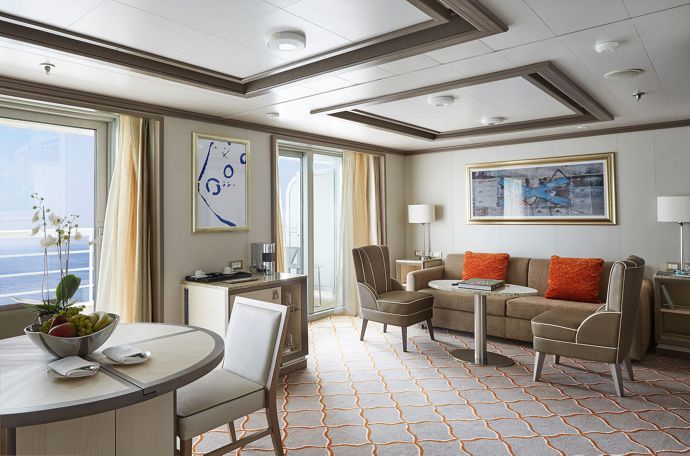
| Grade Code | From | To | |
| SL | Silver Suite | £14,800 | £14,800 |
| S2 | Silver Suite (2 Bedrooms) | £24,800 | £24,800 |
Step onto your terrace and bask in the calm feeling of the ocean breeze. Dissolve into the comfort of your king size bed. Prepare for the evening in the beautiful marble bathroom. The upper deck location gives the most spectacular of sea views, the spacious living area allows for comfortable relaxing where cosy nights in become veritable experiences in themselves. The two-bedroom configuration of this suite makes this it the ideal option for families.
One bedroom: 69 sq.m. including veranda
Please note that the 3rd guest will sleep on a comfortable sofa bed in the reception area of the suite.
Two bedroom: 100 sq.m. including veranda
Essentials
Characteristics
Furniture
Media & Communication
Onboard Services
Amenities
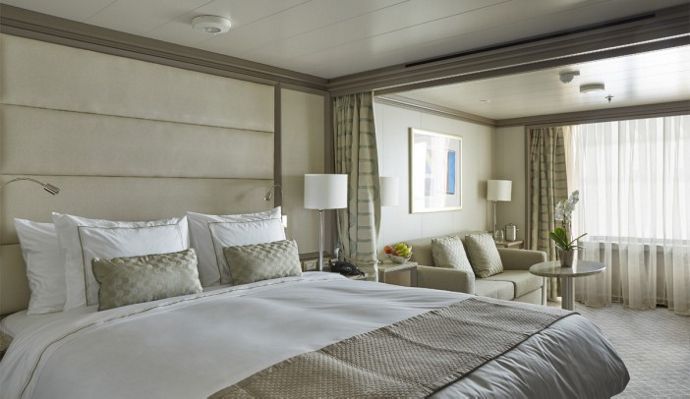
| Grade Code | From | To | |
| VI | Vista Suite | £5,050 | £9,900 |
A quiet sanctuary. The sitting area of the Vista Suite has plenty of room to relax. Large picture windows frame panoramic ocean views. The perfect backdrop for breakfast in bed during the cruise. Some Vista Suites accommodate three guests.
One bedroom: 32 sq.m.
Please note that the 3rd guest will sleep on a comfortable sofa bed in the reception area of the suite.
Essentials
Characteristics
Furniture
Media & Communication
Onboard Services
Amenities
The images shown are for illustration purposes only and may not be an exact representation of what you find on the ship.
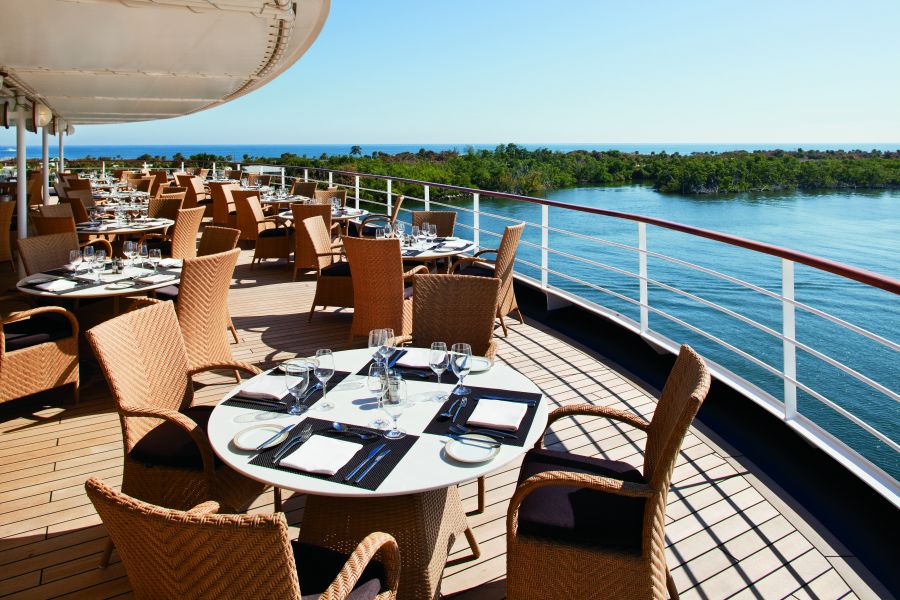
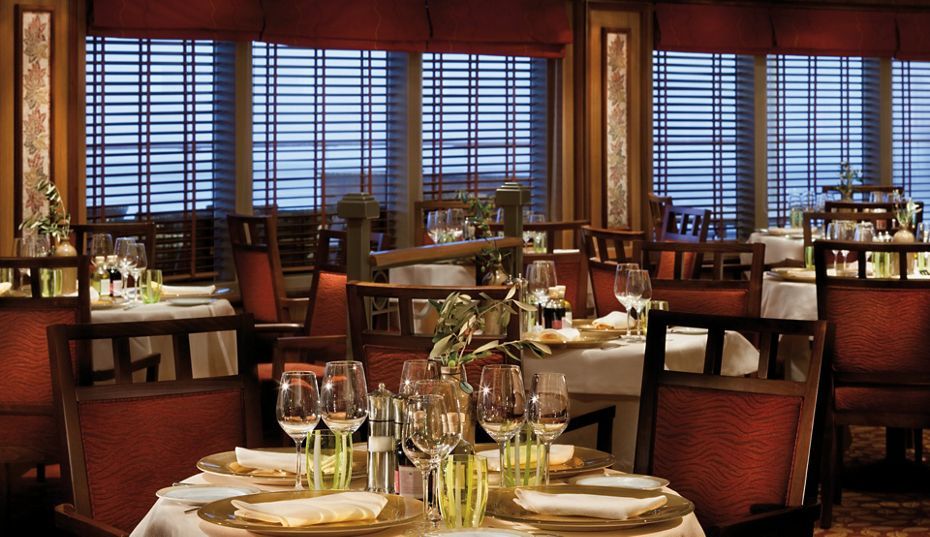
Authentic Italian recipes and the freshest, sustainable ingredients come together in this restaurant at sea.
On board this luxury cruise ship, a divine selection of Italy’s best cuisine is served à la carte in La Terrazza. Authentic recipes and the freshest ingredients come together with flair and passion — a flavourful expression of Silversea’s distinctive Italian herita ge. La Terrazza uses buffalo mozzarella from Naples, organic balsamic vinegar and olive oil from Umbria, and air-dried ham out of Parma. The Emilia-Romagna region also produces Silversea’s 24-month aged Parmigiano Reggiano, while the pasta is made daily right on board.La Terrazza is open for casual, buffet-style breakfast and lunch with indoor or al fresco dining on the outdoor terrace. During the evening, La Terrazza transforms into an à la carte traditional Italian restaurant.
Open-seating for breakfast and lunch. Reservations recommended for dinner.
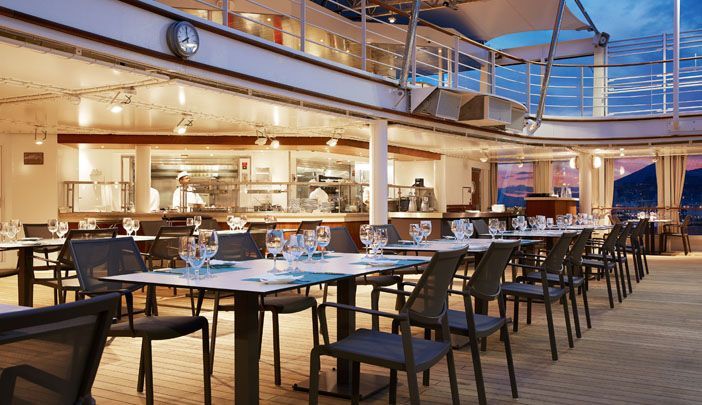
Soft breezes and ocean views beckon at the Grill, especially as the sun goes down when cruise guests gather for cocktails at the outdoor bar and talk about the day’s events.
One of the healthiest cuisines to exist, The Grill features lava stone cooking at its finest. Sourced from volcanic rock and placed in an oven to reach an optimum temperature of 400˚C, The Grill invites guests to cook their food directly at their table. Place your meat, fish or vegetables on top of the grill stone or inside the soup bowl, and then simply cook to your very own taste. Every bite is cooked to perfection, time after time. With the stone cooking available in the evenings only, The Grill becomes a gourmet salad and burger bar, offering build your own burgers from the best selections of meat.
Open seating for lunch. Reservation recommended for dinner.
The images shown are for illustration purposes only and may not be an exact representation of what you find on the ship.

The Library on board this luxury cruise ship has an extensive selection of hardcover books, magazines, reference materials and newspapers, as well as audio listening stations. Movies are also available and can be viewed on your in-suite entertainment centre.
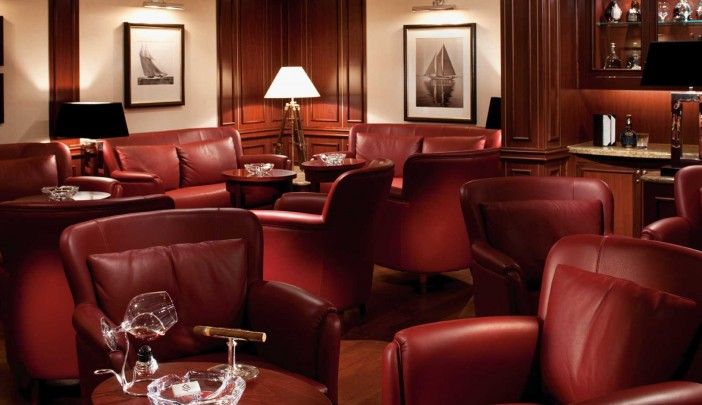
If you appreciate good cognac or premium cigars, be sure to visit the Connoisseur’s Corner to see the ship’s exceptional selection.
Discreet. Tasteful. Polished. If you appreciate the finer things in life, then the sophisticated touches of Connoisseur’s Corner will not disappoint. Rich and luxurious, yet airy and spacious, this indoor/outdoor venue is where you sip the finest cognac or whisky from a prestigious range and revel in the tranquil murmur of after-dinner conversation. A premium choice of cigars is also available, making this a perfect evening haven of serenity.
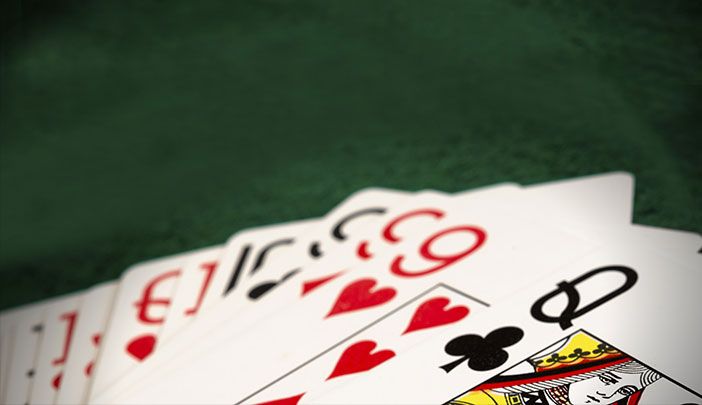
Whether it is for a card tournament or conference, Silversea will provide a dedicated space for the perfect guest experience.
Whatever your conference or meeting requirements, Silversea is pleased to provide a tailor-made experience. Audio-visual equipment is available and complimentary on board this luxury cruise ship.
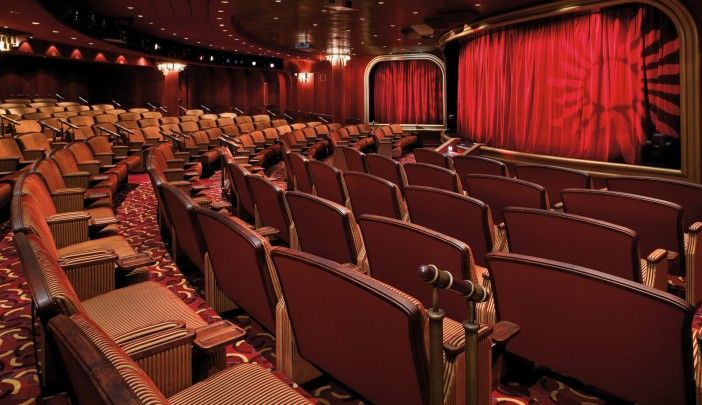
Applaud a broad spectrum of entertainment — from full-scale production shows and classical soloists, to cultural entertainment and feature films. Throughout your voyage, this luxury cruise ship’s Venetian Lounge also presents port talks, enrichment lectures and a variety of special events.
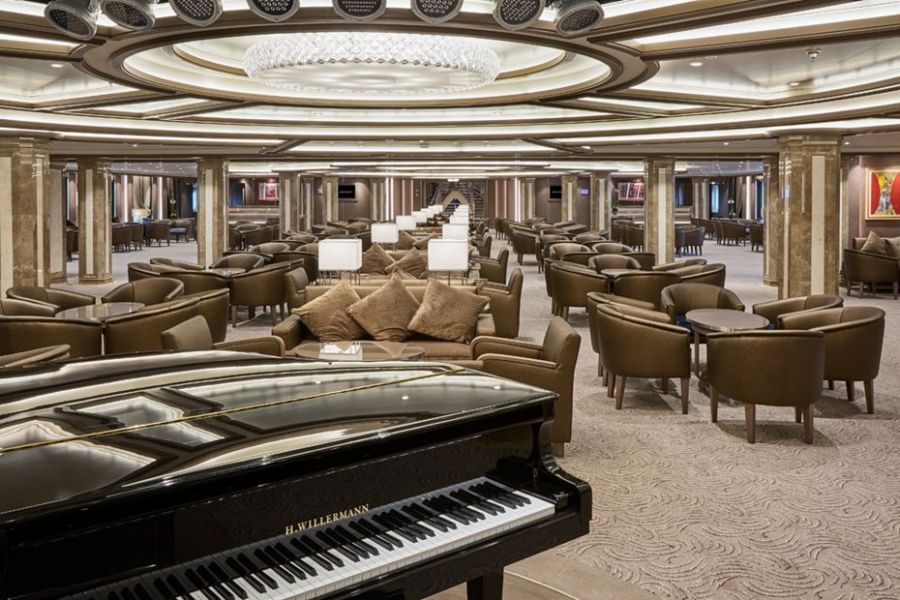
No cruise is complete without meeting new people. Enjoy complimentary drinks and live music at the bar while meeting other guests.
What could be a more fitting name for the very heart of Silver Spirit? Central to the soul and inspiration behind Silversea’s Italian heritage, Dolce Vita is the gathering place for our savvy travellers of the world, a place where guests mingle and exchange stories and where new faces become lifelong friends. Let us spoil you with an incredible array of flawless cocktails, wines and spirits, as you relax, enjoy the evening sounds of a live pianist and enjoy “the sweet life” aboard.
The images shown are for illustration purposes only and may not be an exact representation of what you find on the ship.
The images shown are for illustration purposes only and may not be an exact representation of what you find on the ship.
| Return flights including luggage allowance | |||
| Overseas Transfers | |||
| 14 nights aboard the Silver Spirit | |||
| Butler Service in Every Suite | |||
| Gratuities Always Included | |||
| Beverages In-Suite and Throughout the Ship | |||
| Gourmet Dining | |||
| In Suite Dining & 24-Hour Room Service | |||
| Intimate small size ships | |||
| Free Wifi Throughout the Ship | |||
| Free Zodiac, Land and Sea Tours & Activities & Complimentary Expedition gear | |||
| Port Taxes and Fees | |||
 | ABTA and ATOL Protection* | ||
Fly/cruise package |
Date 27th Aug 2025 |
Nts 14 |
Suite £5,050pp |
Suite £5,050pp |
Suite £5,050pp |
Suite £5,050pp |
Suite £5,050pp |
Suite £5,050pp |
Suite £5,050pp |
Suite £5,050pp |
Suite £5,050pp |
Suite £5,050pp |
Suite £5,050pp |
Suite £5,050pp |
Date 27th Aug 2025 |
Nts 14 |
Suite £5,050pp |
Suite £5,050pp |
Suite £5,050pp |
Suite £5,050pp |
Suite £5,050pp |
Suite £5,050pp |
Suite £5,050pp |
Suite £5,050pp |
Suite £5,050pp |
Suite £5,050pp |
Suite £5,050pp |
Suite £5,050pp |
| Suite staterooms from | £5,050pp | ||
| CV | Classic Veranda Suite | £5,750pp | |
| DX | Deluxe Veranda Suite | £6,250pp | |
| G1 | Grand Suite (1 Bedroom) | £24,400pp | |
| G2 | Grand Suite (2 Bedrooms) |  | |
| O1 | Owner's Suite (1 Bedroom) |  | |
| O2 | Owner's Suite (2 Bedrooms) |  | |
| PA | Panorama Suite | £5,250pp | |
| R1 | Royal Suite (1 Bedroom) | £20,000pp | |
| R2 | Royal Suite (2 Bedrooms) |  | |
| S2 | Silver Suite (2 Bedrooms) |  | |
| SL | Silver Suite |  | |
| SV | Superior Veranda Suite | £6,050pp | |
| VI | Vista Suite | £5,050pp | |
| Suite staterooms from | £5,050pp | ||
| CV | Classic Veranda Suite | £5,750pp | |
| DX | Deluxe Veranda Suite | £6,250pp | |
| G1 | Grand Suite (1 Bedroom) | £24,400pp | |
| G2 | Grand Suite (2 Bedrooms) |  | |
| O1 | Owner's Suite (1 Bedroom) |  | |
| O2 | Owner's Suite (2 Bedrooms) |  | |
| PA | Panorama Suite | £5,250pp | |
| R1 | Royal Suite (1 Bedroom) | £20,000pp | |
| R2 | Royal Suite (2 Bedrooms) |  | |
| S2 | Silver Suite (2 Bedrooms) |  | |
| SL | Silver Suite |  | |
| SV | Superior Veranda Suite | £6,050pp | |
| VI | Vista Suite | £5,050pp | |
| Suite staterooms from | £5,050pp | ||
| CV | Classic Veranda Suite | £5,750pp | |
| DX | Deluxe Veranda Suite | £6,250pp | |
| G1 | Grand Suite (1 Bedroom) | £24,400pp | |
| G2 | Grand Suite (2 Bedrooms) |  | |
| O1 | Owner's Suite (1 Bedroom) |  | |
| O2 | Owner's Suite (2 Bedrooms) |  | |
| PA | Panorama Suite | £5,250pp | |
| R1 | Royal Suite (1 Bedroom) | £20,000pp | |
| R2 | Royal Suite (2 Bedrooms) |  | |
| S2 | Silver Suite (2 Bedrooms) |  | |
| SL | Silver Suite |  | |
| SV | Superior Veranda Suite | £6,050pp | |
| VI | Vista Suite | £5,050pp | |
| Suite staterooms from | £5,050pp | ||
| CV | Classic Veranda Suite | £5,750pp | |
| DX | Deluxe Veranda Suite | £6,250pp | |
| G1 | Grand Suite (1 Bedroom) | £24,400pp | |
| G2 | Grand Suite (2 Bedrooms) |  | |
| O1 | Owner's Suite (1 Bedroom) |  | |
| O2 | Owner's Suite (2 Bedrooms) |  | |
| PA | Panorama Suite | £5,250pp | |
| R1 | Royal Suite (1 Bedroom) | £20,000pp | |
| R2 | Royal Suite (2 Bedrooms) |  | |
| S2 | Silver Suite (2 Bedrooms) |  | |
| SL | Silver Suite |  | |
| SV | Superior Veranda Suite | £6,050pp | |
| VI | Vista Suite | £5,050pp | |
| Suite staterooms from | £5,050pp | ||
| CV | Classic Veranda Suite | £5,750pp | |
| DX | Deluxe Veranda Suite | £6,250pp | |
| G1 | Grand Suite (1 Bedroom) | £24,400pp | |
| G2 | Grand Suite (2 Bedrooms) |  | |
| O1 | Owner's Suite (1 Bedroom) |  | |
| O2 | Owner's Suite (2 Bedrooms) |  | |
| PA | Panorama Suite | £5,250pp | |
| R1 | Royal Suite (1 Bedroom) | £20,000pp | |
| R2 | Royal Suite (2 Bedrooms) |  | |
| S2 | Silver Suite (2 Bedrooms) |  | |
| SL | Silver Suite |  | |
| SV | Superior Veranda Suite | £6,050pp | |
| VI | Vista Suite | £5,050pp | |
| Suite staterooms from | £5,050pp | ||
| CV | Classic Veranda Suite | £5,750pp | |
| DX | Deluxe Veranda Suite | £6,250pp | |
| G1 | Grand Suite (1 Bedroom) | £24,400pp | |
| G2 | Grand Suite (2 Bedrooms) |  | |
| O1 | Owner's Suite (1 Bedroom) |  | |
| O2 | Owner's Suite (2 Bedrooms) |  | |
| PA | Panorama Suite | £5,250pp | |
| R1 | Royal Suite (1 Bedroom) | £20,000pp | |
| R2 | Royal Suite (2 Bedrooms) |  | |
| S2 | Silver Suite (2 Bedrooms) |  | |
| SL | Silver Suite |  | |
| SV | Superior Veranda Suite | £6,050pp | |
| VI | Vista Suite | £5,050pp | |
| Suite staterooms from | £5,050pp | ||
| CV | Classic Veranda Suite | £5,750pp | |
| DX | Deluxe Veranda Suite | £6,250pp | |
| G1 | Grand Suite (1 Bedroom) | £24,400pp | |
| G2 | Grand Suite (2 Bedrooms) |  | |
| O1 | Owner's Suite (1 Bedroom) |  | |
| O2 | Owner's Suite (2 Bedrooms) |  | |
| PA | Panorama Suite | £5,250pp | |
| R1 | Royal Suite (1 Bedroom) | £20,000pp | |
| R2 | Royal Suite (2 Bedrooms) |  | |
| S2 | Silver Suite (2 Bedrooms) |  | |
| SL | Silver Suite |  | |
| SV | Superior Veranda Suite | £6,050pp | |
| VI | Vista Suite | £5,050pp | |
| Suite staterooms from | £5,050pp | ||
| CV | Classic Veranda Suite | £5,750pp | |
| DX | Deluxe Veranda Suite | £6,250pp | |
| G1 | Grand Suite (1 Bedroom) | £24,400pp | |
| G2 | Grand Suite (2 Bedrooms) |  | |
| O1 | Owner's Suite (1 Bedroom) |  | |
| O2 | Owner's Suite (2 Bedrooms) |  | |
| PA | Panorama Suite | £5,250pp | |
| R1 | Royal Suite (1 Bedroom) | £20,000pp | |
| R2 | Royal Suite (2 Bedrooms) |  | |
| S2 | Silver Suite (2 Bedrooms) |  | |
| SL | Silver Suite |  | |
| SV | Superior Veranda Suite | £6,050pp | |
| VI | Vista Suite | £5,050pp | |
| Suite staterooms from | £5,050pp | ||
| CV | Classic Veranda Suite | £5,750pp | |
| DX | Deluxe Veranda Suite | £6,250pp | |
| G1 | Grand Suite (1 Bedroom) | £24,400pp | |
| G2 | Grand Suite (2 Bedrooms) |  | |
| O1 | Owner's Suite (1 Bedroom) |  | |
| O2 | Owner's Suite (2 Bedrooms) |  | |
| PA | Panorama Suite | £5,250pp | |
| R1 | Royal Suite (1 Bedroom) | £20,000pp | |
| R2 | Royal Suite (2 Bedrooms) |  | |
| S2 | Silver Suite (2 Bedrooms) |  | |
| SL | Silver Suite |  | |
| SV | Superior Veranda Suite | £6,050pp | |
| VI | Vista Suite | £5,050pp | |
| Suite staterooms from | £5,050pp | ||
| CV | Classic Veranda Suite | £5,750pp | |
| DX | Deluxe Veranda Suite | £6,250pp | |
| G1 | Grand Suite (1 Bedroom) | £24,400pp | |
| G2 | Grand Suite (2 Bedrooms) |  | |
| O1 | Owner's Suite (1 Bedroom) |  | |
| O2 | Owner's Suite (2 Bedrooms) |  | |
| PA | Panorama Suite | £5,250pp | |
| R1 | Royal Suite (1 Bedroom) | £20,000pp | |
| R2 | Royal Suite (2 Bedrooms) |  | |
| S2 | Silver Suite (2 Bedrooms) |  | |
| SL | Silver Suite |  | |
| SV | Superior Veranda Suite | £6,050pp | |
| VI | Vista Suite | £5,050pp | |
| Suite staterooms from | £5,050pp | ||
| CV | Classic Veranda Suite | £5,750pp | |
| DX | Deluxe Veranda Suite | £6,250pp | |
| G1 | Grand Suite (1 Bedroom) | £24,400pp | |
| G2 | Grand Suite (2 Bedrooms) |  | |
| O1 | Owner's Suite (1 Bedroom) |  | |
| O2 | Owner's Suite (2 Bedrooms) |  | |
| PA | Panorama Suite | £5,250pp | |
| R1 | Royal Suite (1 Bedroom) | £20,000pp | |
| R2 | Royal Suite (2 Bedrooms) |  | |
| S2 | Silver Suite (2 Bedrooms) |  | |
| SL | Silver Suite |  | |
| SV | Superior Veranda Suite | £6,050pp | |
| VI | Vista Suite | £5,050pp | |
| Suite staterooms from | £5,050pp | ||
| CV | Classic Veranda Suite | £5,750pp | |
| DX | Deluxe Veranda Suite | £6,250pp | |
| G1 | Grand Suite (1 Bedroom) | £24,400pp | |
| G2 | Grand Suite (2 Bedrooms) |  | |
| O1 | Owner's Suite (1 Bedroom) |  | |
| O2 | Owner's Suite (2 Bedrooms) |  | |
| PA | Panorama Suite | £5,250pp | |
| R1 | Royal Suite (1 Bedroom) | £20,000pp | |
| R2 | Royal Suite (2 Bedrooms) |  | |
| S2 | Silver Suite (2 Bedrooms) |  | |
| SL | Silver Suite |  | |
| SV | Superior Veranda Suite | £6,050pp | |
| VI | Vista Suite | £5,050pp | |
Fusion Cruises when selling travel arrangements is a trading name of The Midcounties Co-operative Ltd. Fusion Cruises is an Accredited Body Member of Midcounties Co-operative Travel Consortium. (ABTA:P6652, ATOL:6053).
Book with Confidence. We are a Member of ABTA which means you have the benefit of ABTA’s assistance and Code of Conduct.
Some of the flights and flight-inclusive holidays on this website are financially protected by the ATOL scheme but ATOL protection does not apply to all holiday and travel services offered on this website. This website will provide you with information on the protection that applies in the case of each holiday and travel service offered before you make your booking. If you do not receive an ATOL Certificate then the booking will not be ATOL protected. If you do receive an ATOL Certificate but all parts of your trip are not listed on it, those parts will not be ATOL protected. Please see our booking conditions for information, or for more information about financial protection and the ATOL Certificate go to: www.caa.co.uk
